 W
WA reconnaissance vehicle, also known as a scout vehicle, is a military vehicle used for forward reconnaissance. Both tracked and wheeled reconnaissance vehicles are in service. In some nations, light tanks such as the M551 Sheridan and AMX-13 have also been used by scout platoons. Reconnaissance vehicles are usually designed with a low profile or small size and are lightly armoured, relying on speed and cover to escape detection. Their armament ranges from a medium machine gun to a large cannon. Modern examples are often fitted with ATGMs and a wide range of sensors.
 W
WThe BA-20 was an armored car developed in the Soviet Union in 1934. It was intended to replace the FAI and its field trials were completed in 1935. The BA-20 was then used in the early stages of World War II.
 W
WThe BA-21 was an experimental Soviet armored car from 1938. It was a major modification of the BA-20, using a triaxial truck chassis instead of biaxial. The next year, the design was further developed into the LB-23, which had a better engine. Both vehicles were not accepted for production.
 W
WThe BPM-97 or Выстрел is the Russian military designation for the KAMAZ 43269 Vystrel 4×4 wheeled mine-resistant, ambush protected (MRAP) vehicle. It is produced fitted with several different turrets like the one of the BTR-80A. The vehicle is based on the KAMAZ-43269 and as the name suggests was designed for the Russian Border Guards. The latest model has bulletproof side windows and no gun turret. It has been ordered by Kazakhstan and by the National Guard of Russia, Federal Prison Service and EMERCOM.
 W
WBTR (БТР), from Bronetransportyor/Bronetransporter, is any of a series of Soviet or post-Soviet military armoured personnel carriers.
 W
WThe BVP M-80, is a tracked Yugoslavian-made infantry fighting vehicle, produced from the 1980s until the country's collapse in the 1990s.
 W
WThe Combat Vehicle Reconnaissance (Tracked) —or CVR(T)—is a family of armoured fighting vehicles (AFV)s in service with the British Army and others throughout the world. They are small, highly mobile, air-transportable armoured vehicles designed to replace the Alvis Saladin armoured car.
 W
WThe Coventry armoured car (AFVW19) was a British four wheel drive armoured fighting vehicle developed at the end of the Second World War as a potential replacement for the lighter Humber and Daimler armoured cars.
 W
WThe Light Armoured Vehicle II Coyote is an armoured car built by General Dynamics Land Systems Canada for the Canadian Forces, for use in the light reconnaissance (scout) role. It was also initially used in the role of medium tank trainer within armoured cavalry squadrons in the same way as the AVGP Cougar it replaced. In service since 1996, the Coyote is a later generation of the LAV-25 and is of the same family as the Bison APC and the Australian ASLAV, as all are part of the Light Armoured Vehicle family produced by General Dynamics Land Systems - Canada and based on the MOWAG Piranha 8x8.
 W
WThe Daimler Armoured Car was a successful British armoured car design of the Second World War that continued in service into the 1950s. It was designed for armed reconnaissance and liaison purposes. During the postwar era, it doubled as an internal security vehicle in a number of countries.
 W
WThe Fahd is a 4x4 Egyptian armored personnel carrier, designed to fit the requirements of the Egyptian Military. It replaced older APCs in Egyptian service such as the BTR-40, and the Walid. It has been used by eight nations including Egypt, besides being used by the United Nations.
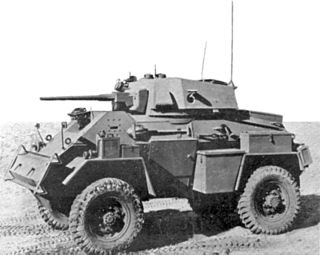 W
WThe Humber Armoured Car was one of the most widely produced British armoured cars of the Second World War. It supplemented the Humber Light Reconnaissance Car and remained in service until the end of the war.
 W
WThe Kfz 13 was the first armoured reconnaissance vehicle introduced by the Reichswehr after the First World War and, by 1935, 147 units of this lightly armoured vehicle had been delivered to the fleet. The Kfz 13 was based on a civilian car, the Adler Standard 6. Although the Kfz 13 was equipped with all-wheel drive, the vehicle had poor cross-country capability. The unarmed version, the Kfz 14 communications vehicle, was equipped with a radio set instead of the machine gun.
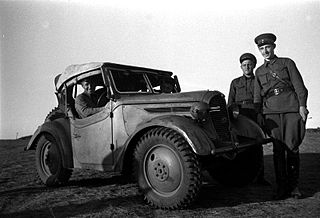 W
WThe Type 95 was a Japanese scout car built by Tokyu Kurogane Industries , and was used during the war with China and World War II in the East. Between 1936 and 1944 approximately 4,700 were built. It was the only completely Japanese designed reconnaissance car ever used by the Imperial Japanese Army, which tended to use civilian cars. Its nickname is the "Yonki" (よんき) which in Japanese means "all-wheel drive". In the field, soldiers often called it the "daruma" after the Buddhist symbol for good luck.
 W
WThe light tank VK 16.02 Leopard was a planned German reconnaissance vehicle designed from mid 1941 through January 1943, with the serial production scheduled for April 1943, but the project was abandoned before the first prototype was complete in January of that same year. The reason for this was that it did not meet the requirements for a 1944 vehicle.
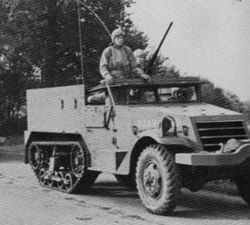 W
WThe M2 half-track car is an armored half-track produced by the United States during World War II. Its design drew upon half-tracks imported from France in the 1930s, employing standard components supplied by U.S. truck manufacturers to speed production and reduce costs. The concept was designed, and the pilot models manufactured by the Firestone Tire and Rubber Company Production by the White Motor Company began in 1940 and was expanded to include Autocar.
 W
WThe M8 Light Armored Car is a 6×6 armored car produced by the Ford Motor Company during World War II. It was used from 1943 by the United States and British troops in Europe and the Far East until the end of the war. The vehicle was widely exported and as of 2006 still remained in service with some countries.
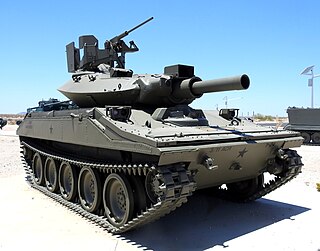 W
WThe M551 "Sheridan" AR/AAV was a light tank developed by the United States and named after General Philip Sheridan, of American Civil War fame. It was designed to be landed by parachute and to swim across rivers. It was armed with the technically advanced but troublesome M81/M81 Modified/M81E1 152mm gun/launcher, which fired both conventional ammunition and the MGM-51 Shillelagh guided anti-tank missile.
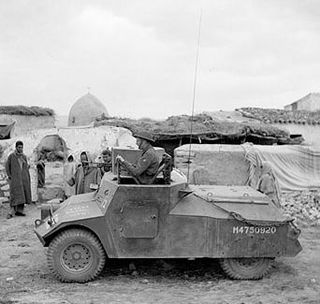 W
WMorris Light Reconnaissance Car (LRC) was a British light armoured car for reconnaissance use produced by Morris Motors Limited and used by the British during the Second World War.
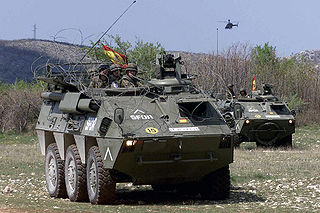 W
WThe Pegaso 3560 BMR is a 6x6 wheeled armoured personnel carrier produced in Spain by Enasa since 1979.
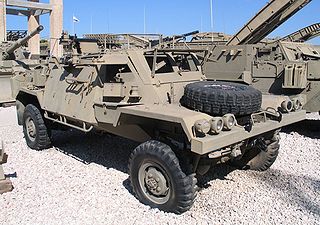 W
WThe RBY Mk 1 is a light armoured reconnaissance vehicle that was produced by the RAMTA Division of Israel Aircraft Industries. RBY is an anglicized acronym for "Rechev Ben-Yaacov". "Rechev" is Hebrew for "vehicle" and "Ben-Yaacov" is the last name of the creator of the vehicle, Yitzchak Ben-Yaacov (1919-2011).
 W
WA scout car is a purpose-built wheeled light armored vehicle used for passive reconnaissance. Scout cars are either unarmed or lightly armed for self-defense and do not carry large caliber weapons systems. This differentiates them from armored cars carrying heavier armament or wheeled infantry fighting vehicles, both of which may also be used for reconnaissance. Scout cars are usually limited to carrying out observation and remaining undetected. Armies which adopted the concept were likelier to place an emphasis on reconnaissance by stealth, unlike others which preferred more heavily armed reconnaissance vehicles designed to fight for information if necessary.
 W
WThe T-27 was a tankette produced in the 1930s by the Soviet Union. It was based on the design of the Carden Loyd tankette, bought under license from the United Kingdom in 1930.
 W
WThe T-37A was a Soviet amphibious light tank. The tank is often referred to as the T-37, although that designation was used by a different tank which never left the prototype stage. The T-37A was the first series of mass-produced fully amphibious tanks in the world.
 W
WThe T-38 amphibious scout tank was a Soviet amphibious light tank that saw service in World War II. Developed as a modernized version of the earlier T-37A light tank, the T-38 proved to be only a moderate improvement over its predecessor, and was eventually replaced in 1940 by the T-40.
 W
WThe T-60 scout tank was a light tank produced by the Soviet Union from 1941 to 1942. During this period, 6,292 units were built. The tank was designed to replace the obsolete T-38 amphibious scout tank.
 W
WThe T-70 was a light tank used by the Red Army during World War II, replacing both the T-60 scout tank for reconnaissance and the T-50 light infantry tank for infantry support. The T-80 light tank was a more advanced version of the T-70 with a two-man turret—it was produced only in very small numbers when light tank production was abandoned. The T-90 self-propelled anti-aircraft gun was a prototype vehicle with twin machine guns, based on the T-70 chassis.
 W
WThe T7 Armored Car was a prototype small armored car produced by Holabird Quartermaster Depot for the US Army in 1930. All six vehicles that were completed, USA W1310, USA W1311, USA W1312, USA W1313, USA W1314 and USA W1315, were 4x6 wheeled vehicles, powered by Franklin's air-cooled, 6-cylinder, gasoline engine, with a crew of four and armed with one .50 calibre machine gun supported by two .30 calibre lighter machine guns.
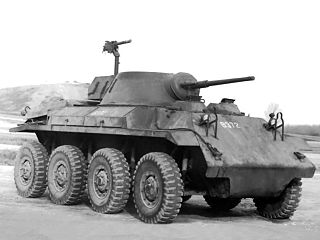 W
WThe T27 Armored Car was a prototype armored car developed for the US Army in 1944 by the Studebaker Corporation. The T27 was an eight-wheeled vehicle, with the first, second and fourth pairs of wheels being powered. With a crew of four, the T27 was armed with two .30 caliber machine guns and a 37 mm cannon. Powered by a Cadillac gasoline eight-cylinder engine, two T27's were produced in 1944.
 W
WThe Type 87 Reconnaissance and Patrol Vehicle, also known as Burakkuai or Type 87 ARV for short, is a 6x6 wheeled Armoured Fighting Vehicle designed and manufactured by multinational heavy industry manufacturer Komatsu Limited and employed exclusively by the Japanese Ground Self-Defense Forces. The JGSDF continued to commission new units up until as recently as 2013
 W
WThe Type 92 Heavy Armoured Car , also known as the Type 92 cavalry tank, was the Empire of Japan's first indigenous tankette. Designed for use by the cavalry of the Imperial Japanese Army by Ishikawajima Motorcar Manufacturing Company, the Type 92 was designed for scouting and infantry support. Although actually a light tank, it was called sōkōsha in Japanese due to political sectionalism within the Japanese Army. Exactly the same device was used in America with the M1 Combat Car.
 W
WThe Type 94 tankette (Japanese: 九四式軽装甲車, Kyūyon-shiki keisōkōsha, literally "94 type light armored car", also known as TK that is abbreviation of "Tokushu Keninsha" that means special tractor was a tankette used by the Imperial Japanese Army in the Second Sino-Japanese War, at Nomonhan against the Soviet Union, and in World War II. Although tankettes were often used as ammunition tractors, and general infantry support, they were designed for reconnaissance, and not for direct combat. The lightweight Type 94 proved effective in China as the Chinese National Revolutionary Army had only three tank battalions to oppose them, and those tank battalions were equipped only with some British export models and Italian CV-33 tankettes. As with nearly all tankettes built in the 1920s and 1930s, they had thin armor that could be penetrated by .50 caliber machine gun fire at 600 yards range.
 W
WThe Type 97 Light armored car Te-Ke was a tankette used by the Imperial Japanese Army in the Second Sino-Japanese War, at Nomonhan against the Soviet Union, and in World War II. It was designed as a fast reconnaissance vehicle, and was a replacement for the earlier Type 94 tankette.
 W
WThe Pegaso VEC-M1 is a Spanish military cavalry reconnaissance vehicle. It started service in the Spanish Army in 1980 as BMR-625 VEC and all of them were upgraded in late 1990s to the M1 version.
 W
WThe Walid is a wheeled armored personnel carrier based on the BTR-152 and the BTR-40, built by the Arab Organization for Industrialization (AOI). It was used by Egypt during the 1967 war with Israel.
 W
WThe Wiesel Armoured Weapons Carrier (AWC) is a German light air-transportable armoured fighting vehicle, more specifically a lightly armoured weapons carrier. It is quite similar to historical scouting tankettes in size, form and function, and is the only true modern tankette in use in Western Europe.